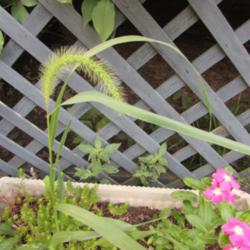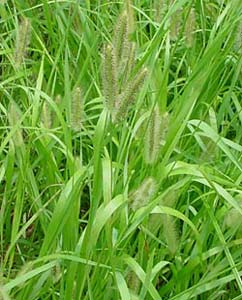
Foxtail (Setaria species) seeds germinate from late spring to fall. This shallow-rooted annual grass prefers sun and grows so fast it can shade out small flowers and vegetables. Closely related species vary in height, from 2 to 5 feet, and all produce furry, bottlebrush seedheads. Below ground, foxtail roots may exude chemicals that act as natural herbicides, reducing the vigor of nearby plants. Control foxtail by mulching to prevent seed germination, pulling or cultivating young plants, or mowing to reduce reseeding. Organic herbicides containing acetic acid will kill back the leaves, but plants will regrow from the roots in a few weeks.
Weed Control TechniquesMulching. Mulch that's more than 2 inches thick can deprive most weed seeds of the light they need to germinate and grow. In vegetable and flower gardens, you can Mulch with wheat straw (which has fewer weed seeds than hay), chopped leaves, grass clippings, or many other organic materials. Where weeds are numerous, try covering the soil with four to six sheets of newspaper. Then cover the newspapers with 2 to 3 inches of organic Mulch. Pieces of scrap carpeting make a good weed-suppressing Mulch to use in pathways between rows. When Mulching beneath shrubs and trees, place a sheet of landscape fabric over the soil, then cover it with 3 inches of organic Mulch. An edging (a 4- to 6-inch-wide strip of rot-proof material driven into the ground vertically) of brick, stone, or metal will help the Mulch stay put, halt invasion by creeping weeds, and make the bed look neat and well groomed.

Pulling. Most young weeds can be pulled from the soil. They will slide out most easily if you pull them when the soil is wet. Getting the root up is crucial, so think of the main stem as the root's handle, and grasp it as close to the soil line as you can. If you find that the weeds are breaking off at the crown as you pull, slip a kitchen fork, dandelion weeder, or similar tool under the weed, and pry and twist as you pull it up. Weeds that have taproots, such as dandelion and plantain, usually must be pried out. A flexible pair of waterproof gloves will keep your hands comfortable as you weed, and it's good to have a nice sitting pad, too. Let pulled weeds bake in the sun for a day or so before composting them. If pulled weeds are holding mature seeds, compost them separately in a hot, moist pile before using this compost in the garden.
Reducing reseeding. Most weeds reproduce primarily from seeds, and the seeds of some weeds can remain viable when buried in the soil for decades. So it's essential to keep weeds from shedding seeds in the garden. Garden weeds that are neglected until they reach seed-bearing age can be lopped off near the soil line with pruning shears, a stout knife, or a string trimmer with a blade attachment. Cutting back perennial weeds again and again not only reduces reseeding, it also forces the plants to use up food reserves stored in their roots. In a garden that has gone hopelessly weedy, mowing it down promptly, raking out the seed-bearing debris, and starting over next year is a big step in the right direction. Mowing regularly helps keep weeds under control in lawns. When mowing lawns where seed-bearing weeds are present, collect the clippings in a bagger and dispose of them in a shady place.
Image courtesy of David Liebman
 |
 |
 |
 |
 |
 |
 |
 |